5 Ultracontemporary Artists Redefining the Korean Art Landscape
The dynamic South Korean art scene is quickly becoming one of the most prominent globally, blending rich traditions with cutting-edge innovation. And...
Carlotta Mazzoli 13 January 2025
Japanese artistic tradition spans centuries and has a far-reaching influence. Today, the artistic scene in Japan is more dynamic than ever, and these five visionary artists are the best representatives of contemporary Japanese art.
Japan boasts a rich artistic tradition spanning centuries and encompassing diverse styles, mediums, and forms of expression. From traditional shodo (calligraphy) to ukiyo-e, Noh theater, or pottery and ceramics, Japan has historically placed itself as one of the foremost global art centers not only in Asia but on a global scale, with a far-reaching influence on neighboring countries and cultures, as well as on European and American arts and crafts.
This influential legacy extends to contemporary art, with a new wave of visionaries reinvigorating Japan’s cultural prominence. These artists skillfully blend Western and Eastern influences, attracting both Japanese and international collectors. This artistic resurgence finds its roots in post-war Japan, intimately tied to the profound changes the country underwent in the aftermath of World War II. From the late ’50s onward, Japan experienced a surge in Western, particularly American, cultural expressions, prompting Japanese artists to either embrace or reject these influences.
Today, contemporary art in Japan still bears Western motifs, but the artists featured in this article have found a way to successfully infuse more traditional or local elements, such as manga, contributing to the Japanese art landscape in their own unique ways. Through their innovative and thought-provoking works, they have bridged cultural gaps, challenged conventions, and left an indelible mark on the ever-evolving world of contemporary art.
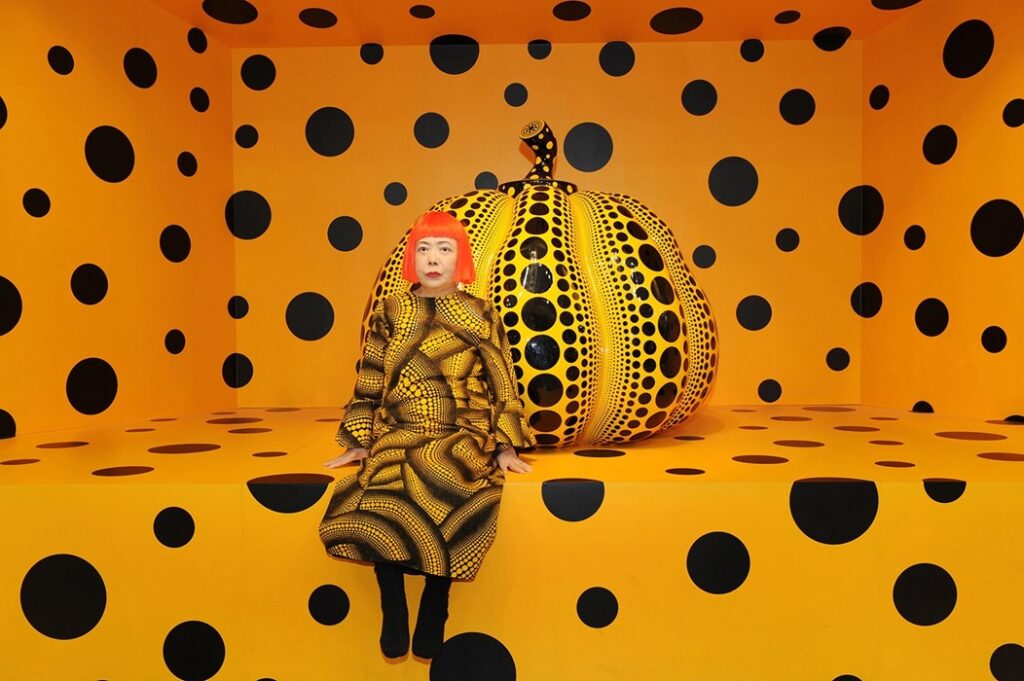
Yayoi Kusama with Pumpkin, 2010 © Ota Fine Arts, Tokyo/ Singapore and Victoria Miro Gallery. Another Mag.
Famous for her polka dots and infinity rooms, Yayoi Kusama is a legendary figure in the contemporary art world, reaching far beyond Japan. Born in 1929, Kusama has been a prominent force in avant-garde art since the 1960s and her work spans painting, installation, film, performance, literature, and fashion. Often dubbed the “Queen of Polka Dots,” Kusama first approached painting as a kid, introducing her signature pattern in watercolors and pastels. In the late 1950s, she moved to the US and became a prominent figure in the New York art scene. Upon her return to Japan, at the end of the 1970s, she faced a decade of oblivion, before being rediscovered at the end of the 1980s and consecrated as one of the most prominent contemporary artists thanks to her participation in the 1993 Venice Biennale, for the Japanese Pavilion.
Nowadays, her immersive installations, characterized by repetitive patterns of dots, mirrors, and vibrant colors, have captivated audiences worldwide, and her dotted pumpkins are among the most recognizable works in contemporary art. The concepts of infinity, repetition, and accumulation are all recurring in her work, creating an otherworldly experience that blurs the boundaries between art and the viewer. The use of patterns and the obsessive repetition of elements was originally a way for Kusama to cope with her intrusive thoughts and a way for the artists to invite the viewers into her mind. In fact, Kusama’s influence extends beyond visual arts. Her unique perspective on life and mental health has added depth to her creations, making her an icon for both artistic and social reasons.
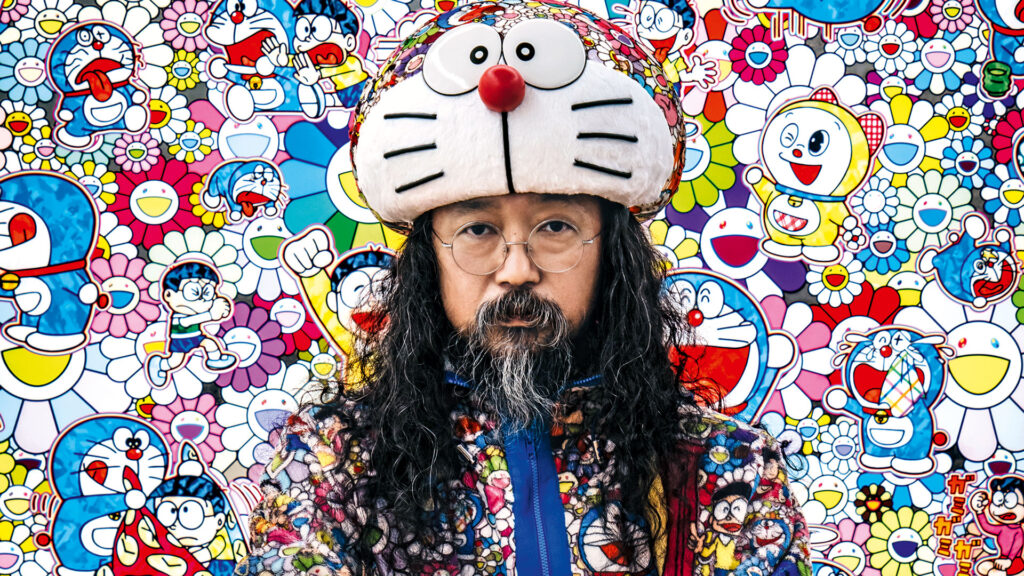
Takashi Murakami/Kaikai Kiki Co., 2019 ©︎ Fujiko-pro. Photo by RK via Instagram.
Second only to Yayoi Kusama in terms of recognizability, Takashi Murakami is another powerhouse in the world of contemporary Japanese art, acknowledged primarily for his vibrant and playful fusion of traditional Japanese and pop culture influences. Born in Tokyo in 1962, Murakami studied Nihonga, a traditional style of Japanese painting, while also appreciating manga and animation. After a one-year stay in New York for the PS1 International Studio Program in 1993, the artist returned to Japan where he started experimenting with his mixture of traditional and pop imageries. In 2000 he first coined the term “Superflat” to describe his artistic style, which often features flat, two-dimensional imagery reminiscent of traditional Japanese art, infused with contemporary themes.
Far from just being aesthetically pleasing, Murakami’s work is a strong critique of Japanese post-war society, as it uses flatness to highlight how Japanese culture has ceased distinguishing between high and low. In doing so, Murakami deliberately mixes the two, producing art from popular culture, as well as merchandise from art, blurring the lines between art, fashion, music, and commercial brands, and showcasing the versatility and accessibility of contemporary art.
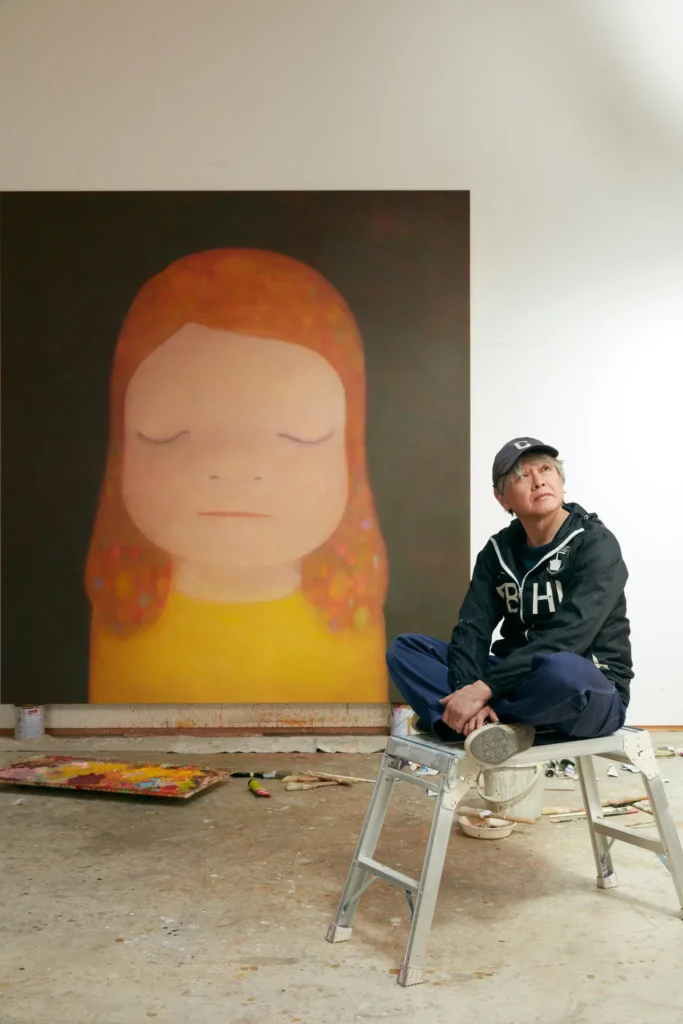
Yoshitomo Nara in his home studio in Tochigi Prefecture, Japan, with one of his bigheaded girl works, Miss Moonlight (2020). Photo by Tetsuya Miura via The New York Times.
Coming from the same generation as Takashi Murakami, Yoshitomo Nara is a Japanese contemporary artist renowned for his emotive and whimsical depictions of children and animals. His work embraces painting, sculpture, and photography, and the most recurring subjects of his works are big-eyed childish figures. Born in 1959 in the Aomori prefecture from a working-class family, Nara spent the first years of his life in a relatively isolated state, which allowed him to hone his imagination. He later discovered punk music, as well as other cultural influences mostly imported from the West, which deeply fascinated him and influenced his later work.
His flat figures, in fact, although reminiscent of manga figures for their large eyes and cute appearance, often carry weapons and threatening tools, and their gaze, looking back at the viewers, is usually charged with unpleasant feelings. This mixture of cartoonish looks and evil intentions is perhaps the most recognizable element in Nara’s work, which explores the duality of innocence and rebellion. At the same time, Nara’s paintings and sculptures evoke a sense of nostalgia and introspection, capturing the universal experiences of childhood and adolescence. His characters, with their big eyes and expressive faces, convey a range of emotions, inviting viewers to connect with the essence of human vulnerability and resilience.
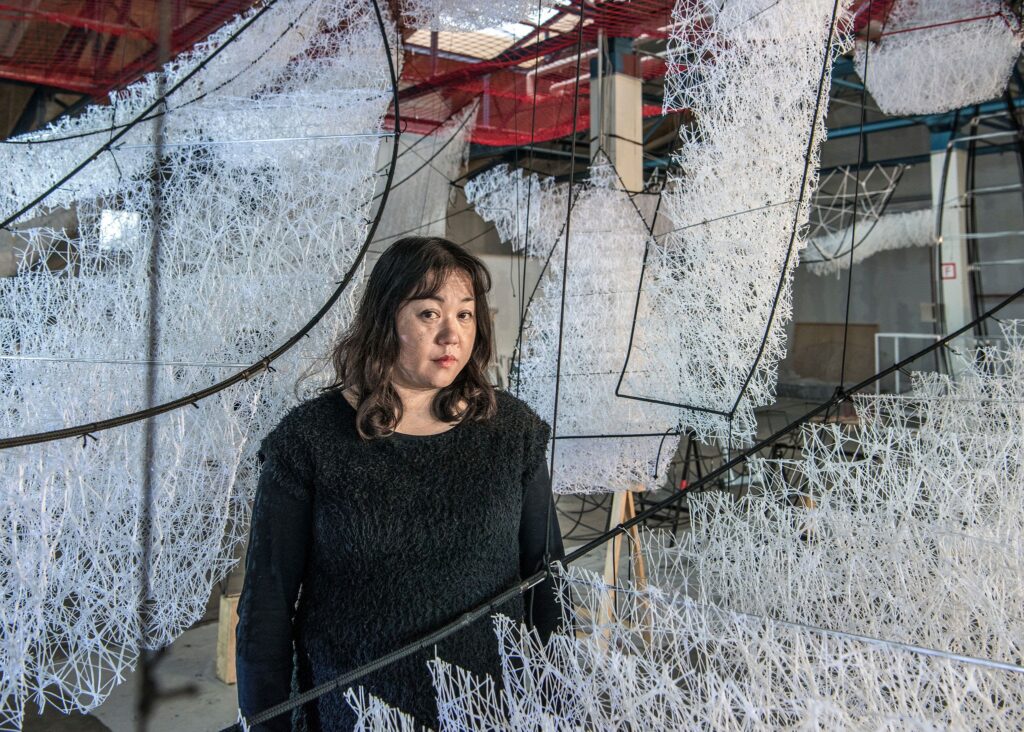
Chiharu Shiota, Portrait © Derek Hudson.
Among younger Japanese artists, Chiharu Shiota is one of the most recognizable and her work has already been featured in important international exhibitions and events, such as the Venice Biennale (2015) and Sydney Biennale (2016). Shiota works primarily with performance and installations, and she is known for her intricate and often ethereal works. Born in Osaka in 1972, Shiota studied first in her native Japan, before moving to Australia and later to Germany. There she studied with Rebecca Horn in Berlin and with Marina Abramović in Braunschweig.
Since the early 2000s, she gained international acclaim for her immersive installations that involve intricate webs of thread suspended in space, often intertwined with keys, doorframes, and other large objects. Her installations often evoke a sense of mystery and introspection, inviting viewers to explore the interconnectedness of memories, emotions, and human experience, as well as alienation. Both in her early performance pieces, as well as in her installations, Shiota also explores the concept of space and the use of the body as a means to perceive and measure space. Through her unique artistic language, Shiota invites viewers to reflect on the intangible threads that link us to our past, present, and future, creating cocoon-like environments that are at once inviting and threatening for the viewers.
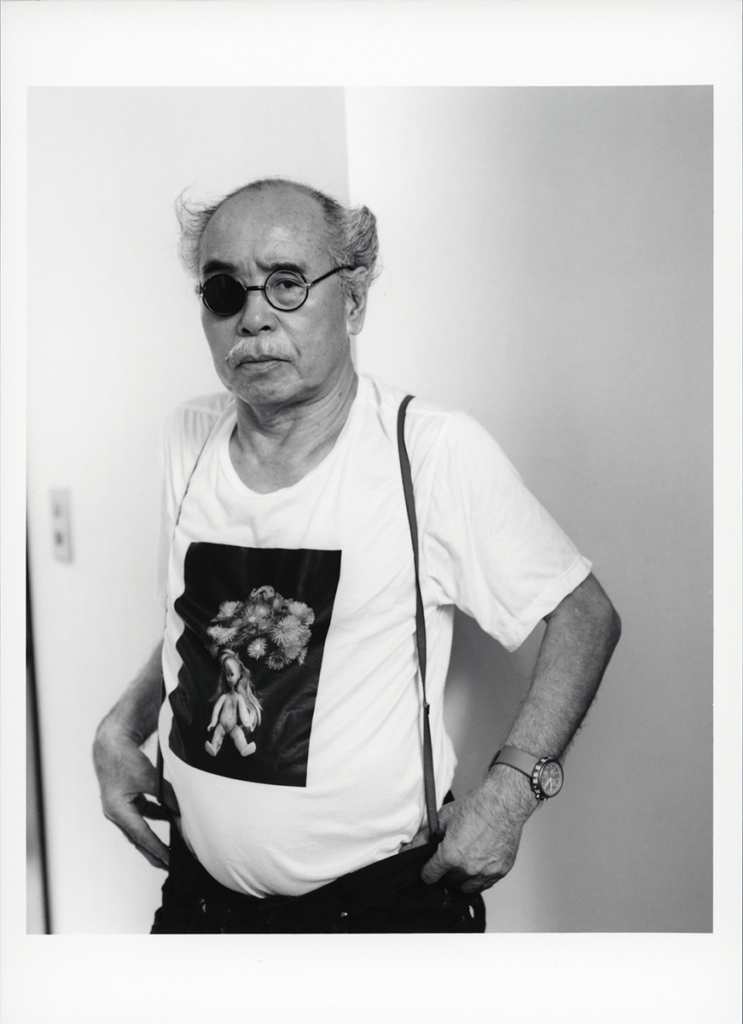
Nobuyoshi Araki, Portrait © Nobuyoshi Araki, Taka Ishii Gallery, Tokyo – SFMOMA.
If we solely concentrate on contemporary photography, then Nobuyoshi Araki is perhaps the most prominent, and definitely one of the most prolific photographers in Japan. Since his debut in 1970, Araki has produced countless pictures and more than five hundred photobooks in total, some of which are real milestones in the genre, not just in Japan but worldwide. Born in Tokyo in 1940, Araki studied at Chiba University, majoring in 1959 in photography and film. He later started working as a commercial photographer for the advertising firm Dentsu, where he met his wife and muse, Yoko Aoki. To document their honeymoon, Araki produced his first photobook in 1971, Sentimental Journey, which launched him as one of the most successful photographers in Japan and allowed him to exclusively focus on his artistic career, leaving his job at Dentsu.
Since the 1970s, his photography has sparked interest and controversy, making him one of the key figures to understand Japanese contemporary art. Blurring the boundaries between art and erotica, Araki is best known for his intimate and provocative exploration of human relationships, capturing moments of vulnerability, passion, and intimacy. His works challenge societal norms and offer a unique perspective on the complexity of human emotions and desires. Beyond his controversial subjects, Araki’s technical mastery, skillful use of different photographic techniques, and dedication to his craft have solidified his place as one of Japan’s most influential contemporary photographers.
DailyArt Magazine needs your support. Every contribution, however big or small, is very valuable for our future. Thanks to it, we will be able to sustain and grow the Magazine. Thank you for your help!